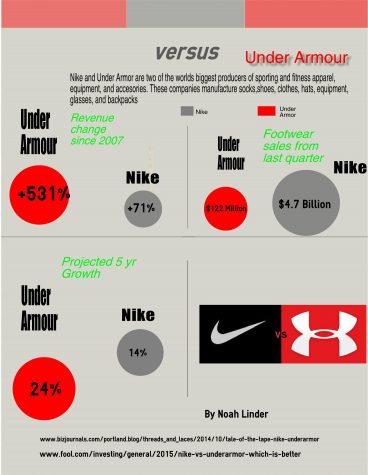Staff Editorial: strong brand names become more powerful
March 15, 2016

In a world dominated by material possessions and social hierarchies based on how you look and how much money you have, brand names and logos have become a major factor in the consumer industry.
Brand names such as Nike and Michael Kors attract spenders across the US that are willing to pay more for clothes with a prestigious a brand name. Many clothes that come from a popular brand cost much more than their common counterparts. Shirts from Under Armor that have the same quality as regular shirts from Target can cost up to $40. These high prices could put businesses out of business.
High school students today are willing to pay obscene amounts for name brand clothes. Under Armor can afford to have expensive clothes because people are willing to pay. By raising their prices more, they make consumers believe that the clothes are that much better.
The reason that people are willing to pay so much more for name brand products is that students associate which clothes you wear with your social status. People with clothes and accessories from popular brands are the people who people want as friends. For some reason, we are willing to be sucked into the flash of overpriced products in the name of perceived quality.
These companies are capitalizing on our loyalty. People who only buy from a select few brands are aiding these brands in another way: advertising. When students buy shirts, shoes, socks, or other products with a “swoosh”, and wear them around the school, they show off what brand they support. People see these popular logos such as a “swoosh” or an “American Eagle” eagle, and subconsciously remember it when they are on their next shopping trip.
After a period of time, a certain company can create a monopoly of a style or article of clothing. By increasing their price and perceived quality, they create a social standard. They can create the system in which students need to wear their clothes or they won’t be cool, or they won’t have style. Every other brand becomes obsolete and the monopoly begins. The prices can afford to go up and hence the need for that brand.
When a class of juniors and seniors in the high school were asked to stand up if they had a brand logo or name showing in their clothing, nobody was left sitting. Slowly and subtly, students’ wardrobes have became very homogeneous with single or few brands. Without realizing, students are becoming walking mannequins for their clothing brands.
This ideology connecting prominent brand logos with social status or financial situations gives “big business” corporations massive advantages over small manufacturers. The large producers outsource their clothes production overseas to produce and manufacture their clothes for much cheaper. In countries with cheap or unregulated labor, large businesses can afford to mass produce their products and spread their influence. When small businesses and family manufactures make clothes and have to sell them at reasonably low price, they are at a serious disadvantage.
Although the most important factor in clothes shopping today is the brand, many other factors come into play. People want clothes and equipment with good quality. If something isn’t going to last or isn’t going to stay cozy, why buy it? These name brands have a habit of convincing the buyer they will look good. It is much easier to imagine yourself in your stylish new Michael Kors shades than in shades from a store called “Noah’s Backyard Shade Shack.”
This loyalty and blindness has come and is strongly affecting our choice in clothing. The clothing and equipment markets are controlled by massive corporations with prominent brand names and logos. People know that when they buy an Aeropostale shirt they will be showing off. These logos have created a social system based on your brand rather than your character. What brands you can afford is how you are measured. Students in society should focus on values such as character and personality over ostentatious fashion.







Laura Ilkka • May 6, 2016 at 6:38 am
Good job on this article, you made your point very clear. Although you lacked quotes, you did do a great job with researching your topic and putting in a lot of information.
Sydney Slusher • May 6, 2016 at 6:09 am
Very well written, you showed your opinion brand names and how they effect us very well. Use of language helps get your point across on how you feel about the situation.
Cassie Hansen • Mar 29, 2016 at 10:42 pm
You really nailed your point on how brand names affect us and your strong opinion only made the article more interesting to read. The strong language and analogy help keep the article going. The only thing you could do to improve would be to add quotes in.
Kai Knudson • Mar 29, 2016 at 8:27 am
I’m glad this article took a more negative approach towards brand names, through talking about their relatively overpriced cost and how their actual quality is similar to generic products.
Christopher Gilleo • Mar 29, 2016 at 8:20 am
The article is really well written. You’re not just preaching about brands you hate, you actually have economic facts and theories to back you up. You also don’t seem stubborn in your opinion, making it more welcoming.